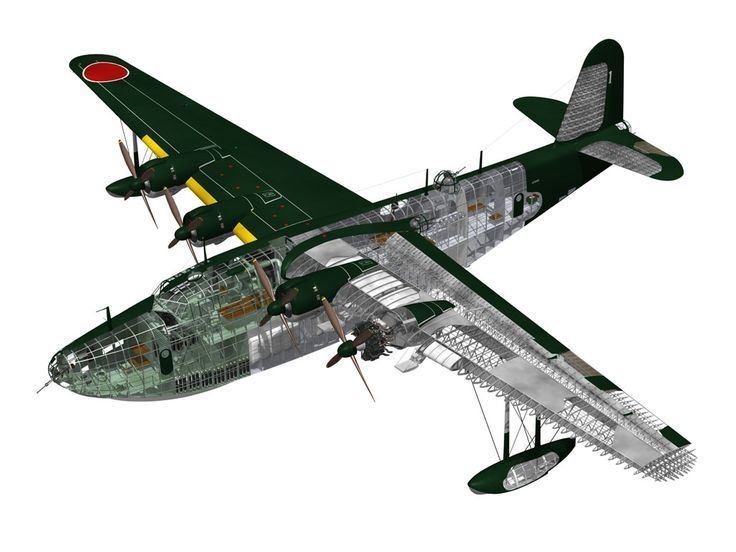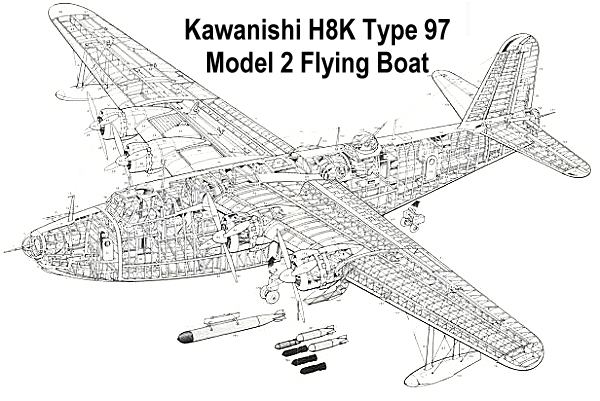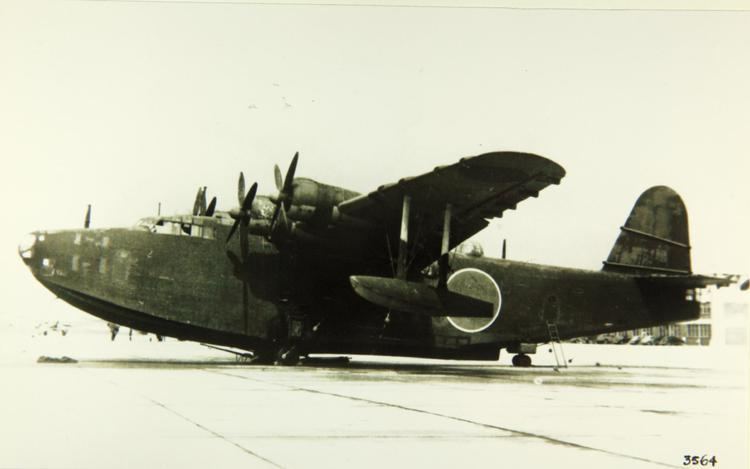Top speed 465 km/h Wingspan 38 m | Range 7,150 km Length 28 m First flight January 1941 | |
 | ||
Manufacturer Kawanishi Aircraft Company | ||
Worlds largest rc flying boat kawanishi h8k
The Kawanishi H8K (二式飛行艇, Nishiki Hikōtei, Type 2 Flying Boat. Commonly called as 二式大型飛行艇 Nishiki Ōgata Hikōtei, 二式大艇 Nishiki Daitei or Nishiki Taitei, Type 2 Large-sized flying boat) was an Imperial Japanese Navy flying boat used during World War II for maritime patrol duties. The Allied reporting name for the type was "Emily".
Contents
- Worlds largest rc flying boat kawanishi h8k
- Kawanishi h8k emily
- Design and development
- Operational history
- Operators
- Surviving aircraft
- Specifications Kawanishi H8K2
- References
Kawanishi h8k emily
Design and development

At the same time the type's predecessor, the Kawanishi H6K, was going into service in 1938 the Navy ordered the development of a larger, longer-ranged patrol aircraft under the designation Navy Experimental 13-Shi Large-size Flying Boat. The result was a large, shoulder-winged design that is widely regarded as the best flying boat of the war. Despite this, initial development was troublesome, with the prototype displaying terrible handling on the water. Deepening of the hull, redesigning of the planing bottom and the addition of spray strips under the nose rectified this Two further prototypes— actually pre-production aircraft— joined the development program in December 1941.

The IJNAF accepted the first production version as the H8K1, Navy Type 2 Flying Boat, Model 11, of which 14 would be built.

The improved H8K2 variant soon appeared, and its extremely heavy defensive armament earned it deep respect among Allied aircrews. The H8K2 was an upgrade over the H8K1, having more powerful engines, slightly revised armament, and an increase in fuel capacity. This was to be the definitive variant, with 112 produced.

36 examples of a dedicated transport version, the H8K2-L, were also built, capable of carrying 62 troops. This aircraft was also known as Seiku (晴空, "Clear Sky"). The side defensive blisters, ventral defensive hatch, and dorsal turret were discarded. To increase the available space within the aircraft, its hull tanks were removed, thus reducing its range.
Operational history

The H8K entered production in 1941 and first saw operational use on the night of 4 March 1942 in a second raid on Pearl Harbor. Since the target lay out of range for the flying boats, this audacious plan involved a refuelling by submarine at French Frigate Shoals, some 900 km (560 mi) north-west of Hawaii, en route. Two planes from the Yokohama Kōkūtai (Naval Air Corps) attempted to bomb Pearl Harbor, but, due to poor visibility, did not accomplish any significant damage.
Six days after the second Pearl Harbor raid one of the Emilys was sent on a daylight photo-recon mission of Midway Atoll. It was intercepted by radar directed Brewster Buffalo fighters of Marine Corps squadron VMF-221 and shot down. All aboard were killed including Lt. Hashizume Hisao, the lead pilot of the second Pearl Harbor raid.
H8K2s were used on a wide range of patrol, reconnaissance, bombing, and transport missions throughout the Pacific War. The H8K2 was given the Allied code name "Emily".
Operators
Surviving aircraft
Four aircraft survived until the end of the war. One of these, an H8K2 (work number 426), was captured by U.S. forces at the end of the war and was evaluated before being eventually returned to Japan in 1979. It was on display at Tokyo's Museum of Maritime Science until 2004, when it was moved to Kanoya Air Base in Kagoshima.
The submerged remains of an H8K can be found off the west coast of Saipan, where it is a popular scuba diving attraction known erroneously as the "B-29", or the "Emily". Another wrecked H8K lies in Chuuk Lagoon, Chuuk, in Micronesia. This aircraft is located off the south-western end of Dublon Island.
Specifications (Kawanishi H8K2)
Data from Jane’s Fighting Aircraft of World War II
General characteristics
Performance
)Armament
Avionics
